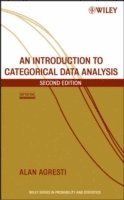
- Format
- Inbunden (Hardback)
- Språk
- Engelska
- Antal sidor
- 400
- Utgivningsdatum
- 2007-04-01
- Upplaga
- 2nd Edition
- Förlag
- John Wiley & Sons Inc
- Illustrationer
- Illustrations
- Dimensioner
- 242 x 160 x 24 mm
- Vikt
- Antal komponenter
- 1
- Komponenter
- Gb
- ISBN
- 9780471226185
- 700 g
An Introduction to Categorical Data Analysis
Kundrecensioner
Fler böcker av Alan Agresti
-
Statistics: The Art and Science of Learning from Data, Global Edition
Alan Agresti, Christine Franklin, Bernhard Klingenberg, Christine A Franklin
-
Foundations of Statistics for Data Scientists
Alan Agresti, Maria Kateri
-
Analysis of Ordinal Categorical Data
Alan Agresti, Alan Agresti
Recensioner i media
"Yes, I fully recommend the text as a basis for introductory course, for students, as well as non-specialists in statistics. The wealth of examples provided in the text is, from my point of view, a rich source of motivating ones own studies and work." (Biometrical Journal, Dec 2008) "This text does a good job of achieving its state goal, and we enthusiastically recommend it." (Journal of the American Statistical Association Sept 2008) "This book is very well-written and it is obvious that the author knows the subject inside out." (Journal of Applied Statistics, April 2008) "Provides an applied introduction to the most important methods for analyzing categorical data, such as chi-squared tests and logical regression." (Statistica 2008) "This is an introductory book and as such it is marvelous...essential for a novice..." (MAA Reviews, June 26, 2007)
Övrig information
ALAN AGRESTI, PhD, is Distinguished Professor Emeritus in the Department of Statistics at the University of Florida. He has presented short courses on categorical data methods in thirty countries. Dr. Agresti was named "Statistician of the Year" by the Chicago chapter of the American Statistical Association in 2003. He is the author of two advanced texts, including the bestselling Categorical Data Analysis (Wiley) and is also the coauthor of Statistics: The Art and Science of Learning from Data and Statistical Methods for the Social Sciences.
Innehållsförteckning
Preface to the Second Edition. 1. Introduction. 1.1 Categorical Response Data. 1.1.1 Response/Explanatory Variable Distinction. 1.1.2 Nominal/Ordinal Scale Distinction. 1.1.3 Organization of this Book. 1.2 Probability Distributions for Categorical Data. 1.2.1 Binomial Distribution. 1.2.2 Multinomial Distribution. 1.3 Statistical Inference for a Proportion. 1.3.1 Likelihood Function and Maximum Likelihood Estimation. 1.3.2 Significance Test About a Binomial Proportion. 1.3.3 Example: Survey Results on Legalizing Abortion. 1.3.4 Confidence Intervals for a Binomial Proportion. 1.4 More on Statistical Inference for Discrete Data. 1.4.1 Wald, Likelihood-Ratio, and Score Inference. 1.4.2 Wald, Score, and Likelihood-Ratio Inference for Binomial Parameter. 1.4.3 Small-Sample Binomial Inference. 1.4.4 Small-Sample Discrete Inference is Conservative. 1.4.5 Inference Based on the Mid P-value. 1.4.6 Summary. Problems. 2. Contingency Tables. 2.1 Probability Structure for Contingency Tables. 2.1.1 Joint, Marginal, and Conditional Probabilities. 2.1.2 Example: Belief in Afterlife. 2.1.3 Sensitivity and Specificity in Diagnostic Tests. 2.1.4 Independence. 2.1.5 Binomial and Multinomial Sampling. 2.2 Comparing Proportions in Two-by-Two Tables. 2.2.1 Difference of Proportions. 2.2.2 Example: Aspirin and Heart Attacks. 2.2.3 Relative Risk. 2.3 The Odds Ratio. 2.3.1 Properties of the Odds Ratio. 2.3.2 Example: Odds Ratio for Aspirin Use and Heart Attacks. 2.3.3 Inference for Odds Ratios and Log Odds Ratios. 2.3.4 Relationship Between Odds Ratio and Relative Risk. 2.3.5 The Odds Ratio Applies in Case-Control Studies. 2.3.6 Types of Observational Studies. 2.4 Chi-Squared Tests of Independence. 2.4.1 Pearson Statistic and the Chi-Squared Distribution. 2.4.2 Likelihood-Ratio Statistic. 2.4.3 Tests of Independence. 2.4.4 Example: Gender Gap in Political Affiliation. 2.4.5 Residuals for Cells in a Contingency Table. 2.4.6 Partitioning Chi-Squared. 2.4.7 Comments About Chi-Squared Tests. 2.5 Testing Independence for Ordinal Data. 2.5.1 Linear Trend Alternative to Independence. 2.5.2 Example: Alcohol Use and Infant Malformation. 2.5.3 Extra Power with Ordinal Tests. 2.5.4 Choice of Scores. 2.5.5 Trend Tests for I x 2 and 2 x J Tables. 2.5.6 Nominal-Ordinal Tables. 2.6 Exact Inference for Small Samples. 2.6.1 Fisher's Exact Test for 2 x 2 Tables. 2.6.2 Example: Fisher's Tea Taster. 2.6.3 P-values and Conservatism for Actual P(Type I Error). 2.6.4 Small-Sample Confidence Interval for Odds Ratio. 2.7 Association in Three-Way Tables. 2.7.1 Partial Tables. 2.7.2 Conditional Versus Marginal Associations: Death Penalty Example. 2.7.3 Simpson's Paradox. 2.7.4 Conditional and Marginal Odds Ratios. 2.7.5 Conditional Independence Versus Marginal Independence. 2.7.6 Homogeneous Association. Problems. 3. Generalized Linear Models. 3.1 Components of a Generalized Linear Model. 3.1.1 Random Component. 3.1.2 Systematic Component. 3.1.3 Link Function. 3.1.4 Normal GLM. 3.2 Generalized Linear Models for Binary Data. 3.2.1 Linear Probability Model. 3.2.2 Example: Snoring and Heart Disease. 3.2.3 Logistic Regression Model. 3.2.4 Probit Regression Model. 3.2.5 Binary Regression and Cumulative Distribution Functions. 3.3 Generalized Linear Models for Count Data. 3.3.1 Poisson Regression. 3.3.2 Example: Female Horseshoe Crabs and their Satellites. 3.3.3 Overdispersion: Greater Variability than Expected. 3.3.4 Negative Binomial Regression. 3.3.5 Count Regression for Rate Data. 3.3.6 Example: British Train Accidents over Time. 3.4 Statistical Inference and Model Checking. 3.4.1 Inference about Model Parameters. 3.4.2 Example: Snoring and Heart Disease Revisited. 3.4.3 The Deviance. 3.4.4 Model Comparison Using the Deviance. 3.4.5 Residuals Comparing Observations to the Model Fit. 3.5 Fitting Generalized Linear Models. 3.5.1 The Newton-Raphson Algorithm Fits GLMs. 3.5.2 Wald, Likelihood-Ratio, and Score Inference Use the Likelihood Function. 3.5.3 Advantages of GLMs. Problems. 4.
Du kanske gillar
-
Nexus
Yuval Noah Harari
Häftad
